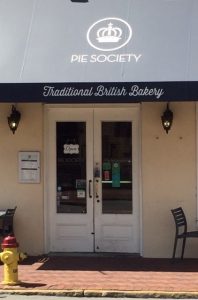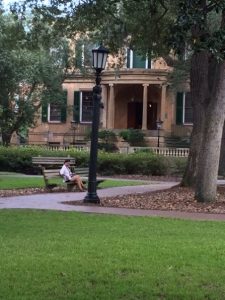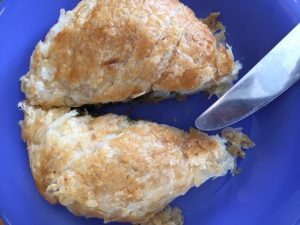As a plan B from our rained-out (Hurricane Florence) trip planned for Wilmington, NC, we ended up in Savannah, Georgia. Georgia, the 13th (and last) American colony, was established in 1733 when General James Oglethorpe landed along the Savannah River and named the colony Georgia after England’s King George II. Savannah became the first city of this new region.
While Savannah is most famous for its charming squares (think Midnight in the Garden of Good and Evil) and has more haunted houses than New Orleans, we particularly enjoyed the waterfront along the Savannah River.  The Port of Savannah is the fourth largest container terminal in the US and stretches from the Atlantic Ocean 18 miles inland with container ships docked along the way on both sides of the river. The port has plans to dredge the river to accommodate the new deep water “supermax ships.”
The Port of Savannah is the fourth largest container terminal in the US and stretches from the Atlantic Ocean 18 miles inland with container ships docked along the way on both sides of the river. The port has plans to dredge the river to accommodate the new deep water “supermax ships.”
During an informative trolley tour, we stopped at the Savannah City Market for lunch. The Market occupies a four block square area in the historic center of the city. It has been open since the 1700s and has plenty of restaurants and shops tucked in restored warehouses. As a nod to Savannah’s British origins, we had our Savannah pie fix at Pie Society, a traditional British Bakery that serves British fare such as steak and kidney pot pie and meat- and mushroom- filled pasties, along with a few fruit pies and cheesecakes. We had the beef and basil pasty in honor of Oglethrope.
a traditional British Bakery that serves British fare such as steak and kidney pot pie and meat- and mushroom- filled pasties, along with a few fruit pies and cheesecakes. We had the beef and basil pasty in honor of Oglethrope.
People: James Oglethorpe. Not only did General Oglethorpe locate Savannah at this spot along the river, he also designed the plan for the 22 garden-like squares most of which have now been preserved in Savannah’s historic district. Sitting on a bench in one of the squares with a pasty for lunch would make a perfect rest stop on a busy day of sightseeing. The General was a visionary!
Places: Pie Society, Traditional British Bakery. This is a small shop, you could think of it as a market stall, selling sweet and savory pies. The lines were long and people were carrying out their lunch. Pie Society, 19 Jefferson Street, Savannah, GA. www.thebritishpiecompany.com
Pies: Pasties are meat hand pies, usually filled with meat and  vegetables in a pastry crust. This “pie” originated in Cornwall England and was enjoyed by miners who took the pie to work for their lunch. During our visit we also had a Georgia peach pie and a brandy-pecan pie—of course we did!
vegetables in a pastry crust. This “pie” originated in Cornwall England and was enjoyed by miners who took the pie to work for their lunch. During our visit we also had a Georgia peach pie and a brandy-pecan pie—of course we did!
- For the pastry
- 500g/1lb 1oz strong bread flour
- 120g/4oz vegetable shortening or suet
- 1 tsp salt
- 25g/1oz margarine or butter
- 175ml/6fl oz cold water
- 1 free-range egg, beaten with a little salt (for glazing)
- For the filling
- 350g/12oz good-quality beef skirt, rump steak or braising steak
- 350g/12oz waxy potatoes
- 200g/7oz swede
- 175g/6oz onions
- salt and freshly ground black pepper
- knob of butter or margarine
- Tip the flour into the bowl and add the shortening, a pinch of salt, the margarine or butter and all of the water.Use a spoon to gently combine the ingredients. Then use your hands to crush everything together, bringing the ingredients together as a fairly dry dough.
- Turn out the dough onto a clean work surface (there’s no need to put flour or oil onto the surface because it’s a tight rather than sticky dough).Knead the dough to combine the ingredients properly. Use the heel of your hand to stretch the dough. Roll it back up into a ball, then turn it, stretch and roll it up again. Repeat this process for about 5-6 minutes. The dough will start to become smooth as the shortening breaks down. If the dough feels grainy, keep working it until it’s smooth and glossy. Don’t be afraid to be rough – you’ll need to use lots of pressure and work the dough vigorously to get the best results.
- When the dough is smooth, wrap it in cling film and put it in the fridge to rest for 30–60 minutes.
- While the dough is resting, peel and cut the potato, swede and onion into cubes about 1cm/½in square. Cut the beef into similar sized chunks. Put all four ingredients into a bowl and mix. Season well with salt and some freshly ground black pepper, then put the filling to one side until the dough is ready.
- Lightly grease a baking tray with margarine (or butter) and line with baking or silicone paper (not greaseproof).
- Preheat the oven to 170C (150C fan assisted)/325F/Gas 3.
- Once the dough has had time to relax, take it out of the fridge. The margarine or butter will have chilled, giving you a tight dough. Divide the dough into four equal-sized pieces. Shape each piece into a ball and use a rolling pin to roll each ball into a disc roughly 25cm/10in wide (roughly the same size as a dinner plate).
- Spoon a quarter of the filling onto each disc. Spread the filling on one half of the disc, leaving the other half clear. Put a knob of butter or margarine on top of the filling.Carefully fold the pastry over, join the edges and push with your fingers to seal. Crimp the edge to make sure the filling is held inside – either by using a fork, or by making small twists along the sealed edge. Traditionally Cornish pasties have around 20 crimps. When you’ve crimped along the edge, fold the end corners underneath.
- Put the pasties onto the baking tray and brush the top of each pasty with the egg and salt mixture. Bake on the middle shelf of the oven for about 45 minutes or until the pasties are golden-brown. If your pasties aren't browning, increase the oven temperature by 10C/25F for the last 10 minutes of cooking time.

